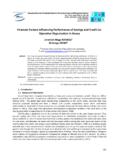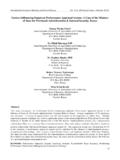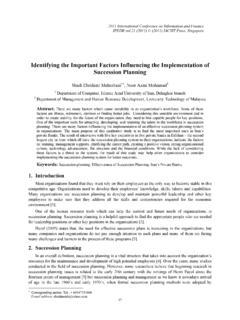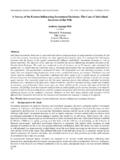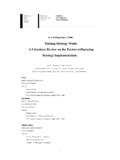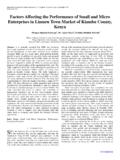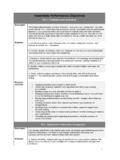Transcription of Factors influencing work participation for people …
1 Factors influencing work participation for people with a visual impairment Information Monitoring Summary Documentary research Jos e Duquette, Planning, Programming and Research Officer Francine Baril, Documentation Technician Prepared by Jos e Duquette, Planning, Programming and Research Officer August 1, 2013 Notice to readers The information in the following pages is not intended to be an exhaustive review of the literature. The goal was to make directly relevant selected information more readily available. Accordingly, not all articles or documents dealing with the topic have been reviewed. Authorization to reproduce This document and the accompanying material may be reproduced for clinical, teaching or research purposes with the prior written consent of l Institut Nazareth et Louis-Braille.
2 Modifying this document and the accompanying material in any way whatsoever is strictly prohibited. Any reproduction in whole or in part of this document and the accompanying material for commercial purposes is strictly prohibited. 2013 Institut Nazareth et Louis-Braille Factors influencing work participation for people with a visual impairment Summary Although individuals who have a visual impairment have an education level comparable to that of the general population, they are proportionally much less likely to be employed. In 2006, according to the Canadian participation and Activity Limitation Survey, only 35% of individuals aged 15-64 who had a visual limitation reported having a job. This rate was significantly lower than that of Quebec individuals without impairments (73%).
3 A number of personal and environmental Factors are associated with work participation by people with a visual impairment. Some personal Factors are not modifiable ( severity of visual impairment, age and sex, age at onset of visual impairment, presence of one or more additional impairments). Some personal abilities and life habits, however, can be modified to increase work participation potential ( behaviour, communication and mobility skills, responsibilities, education, work , job search). Several environmental Factors also have an influence on the probability of obtaining and retaining employment ( receiving special education, rehabilitation and career counseling services, living environment, residential location, workplace/attitudes and accessibility).
4 The importance of vocational rehabilitation is obvious. It increases access to and retention of employment, its interventions being focused on personal Factors ( work -related compensatory skills; behaviour) as well as on environmental Factors of a social ( . employer behaviour) and physical ( work -site and workstation layout) nature. Early intervention is a key component of successful vocational rehabilitation interventions. In addition to work readiness, integration and retention phases, a preliminary phase should be provided to teenagers. It is also important to develop an integrated path between rehabilitation (including pediatric and adult articulation), education and work settings, social and governmental organizations and others.
5 1 Factors influencing work participation for people with a visual impairment 1. The employment situation for people with a visual impairment It is recognized that inclusion in the workplace is critical to full participation in society and to financial independence. But people with visual impairments (VI) have historically been under-represented in the labour market. people with physical disabilities are likely to be confronted with barriers that limit their social participation , especially as regards access to the labour market. Government policies have facilitated their integration into the labour market. In the province of Quebec, the gale social integration policy adopted in 1984, and more recently the National Strategy for Labour Market Integration and Maintenance of Handicapped Persons in 2008, are examples [14].
6 However, the employment rate for individuals who have VI remains far below that of the general population, despite the fact that their education level is comparable [35]. The Canadian participation and Activity Limitation Survey (PALS), published in 2006, found that among people aged 15-64 who had a visual limitation, only a third (35%) reported being employed [6], compared to 73% of Quebecers without impairments [7] . The employment rate of people with VI is also lower than the population with other types of physical disabilities, as noticed by Shaw et al. (2007). Only 41% of their participants aged 22-30 years were employed. This rate was significantly lower than that of the population aged 25-54 who had physical disabilities in general (51%) or who had none (82%) (Government of Canada, 2002, cited by Shaw et al.)
7 2007). Many people with VI face barriers to their participation in work . For example, this was the case for 59% of individuals interviewed by Shaw et al. (2007) and 79% of participants in the La Grow & Daye New Zealand study (2005). In the PALS, 56% of employed working-age individuals who had VI reported that their condition limited the amount and type of work they could do [6] . The non- participation of this population in work activities resulted in an associated productivity loss that caused a $ billion loss to the Canadian economy in 2007 [12]. 2. work participation , work performance and personal capabilities concepts Sandqvist (2007) proposed a conceptual framework of a person s work functioning, based on the International Classification of Functioning, Disability and Health (ICF).
8 The model includes three dimensions involved in work functioning: work participation , work performance and individual capacity. Many of its components are similar to the Quebec Classification: Disability Creation Process developed by Fougeyrollas et al. (1998). 2 work participation is the ability and the possibility of an individual to fulfil a role of worker, thereby obtaining and maintaining a job [33]. According to the ICF, this dimension involves 1 ) learning/ work readiness (e. g. training courses, apprenticeships, on-the-job training, etc.) and 2) seeking, obtaining and keeping a job, getting promotions and other advancements , and terminating employment in an appropriate manner [15]. work performance is the ability to perform in a satisfactory manner various tasks and work activities, and therefore to work [33].
9 It is contextual [15] and refers to the quality and quantity of work [30]. work performance is reflected in skills at various levels: 1) physical; 2) time management, task planning, adaptation to change, problem solving, etc.; 3) communication and social interaction [30]. Individual capacity is the positive expression of an aptitude that allows the individual to perform a working task and activity [17; 33]. It is the person s highest functioning level (maximum capacity) in a given area at a given time, as assessed by a measuring instrument in a uniform or standardized environment [15]. Many capacities, or capabilities, may be called upon in the accomplishment of a work task, such as those related to intellectual activity, behaviour, sense and perception, motor activity, etc.
10 Capacity differs from performance in that it is located in a uniform or standardized environment, whereas performance takes place in a real life context [15; 33]. Interactions between these three different dimensions are multiple [15; 17; 33]. Moreover, the quality of participation , work performance and personal capacity results from the interaction between personal and environmental Factors (facilitators and obstacles of a social and physical nature) [15; 17; 30]. Lastly, Sandvqist (2007) includes the time factor in the model, because of changes that occur over time in individual ( aging, health status changes) and workplace terms ( peak periods, introduction of new technologies, etc.) [30; 33]. Consequently, as noted by Roy et al.


